In our modern smart home, a power outage can quickly turn into a nightmare. Internet box that restarts, surveillance cameras that turn off, voice assistants that go silent… All these inconveniences can be avoided with a often-neglected piece of equipment: the uninterruptible power supply (UPS). Today, I present to you the Eaton 3S Mini, a compact UPS specially designed to protect your small connected devices. No more unexpected restarts of your internet box or interruptions of your surveillance cameras during a power cut!
I have been using UPS devices for years to protect my computer equipment, but I had never found a truly suitable solution for the connected devices in the home. These consume little power but remain vulnerable to the fluctuations of the electrical network. The Eaton 3S Mini fills this gap with a proposal that fits in the hand. Let's see together if this little device can really make a difference in our connected ecosystem.
Unboxing the Eaton 3S Mini
First contact with the Eaton 3S Mini: the packaging is compact and well-designed, with clear information about the product's capabilities.
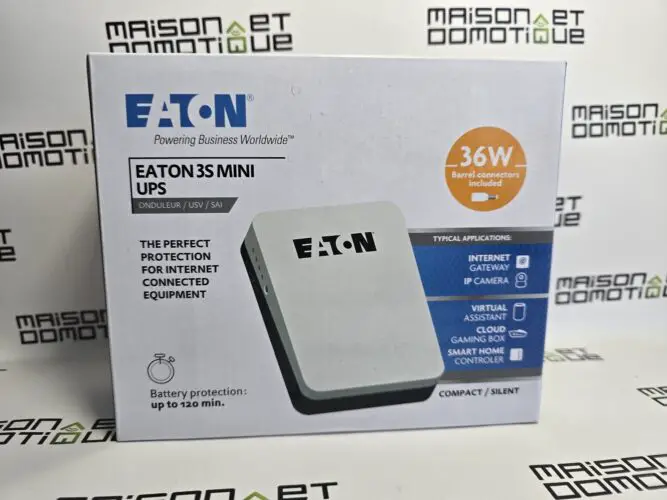
It indicates that the autonomy can reach up to 120 minutes, which seems impressive for such a small device.
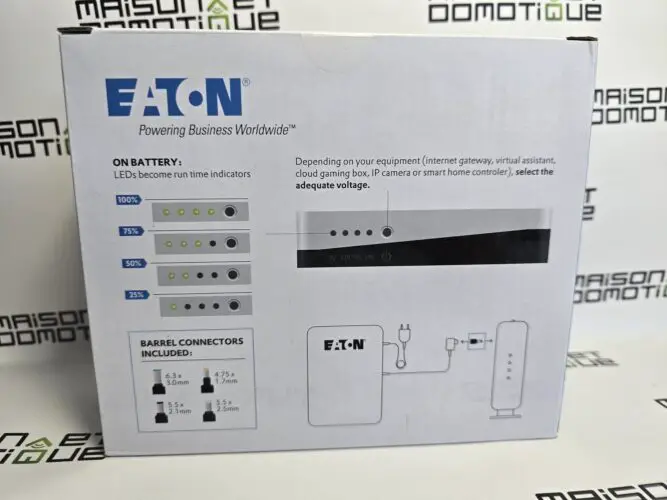
But let’s not get too carried away, this autonomy will obviously depend on the consumption of the connected device.
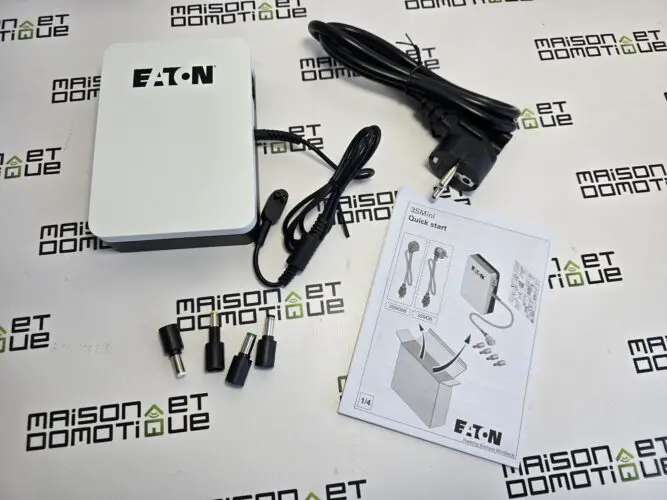
Upon opening the box, we discover:
- The Eaton 3S Mini UPS
- A power cable
- Four different adapter tips to suit various devices
- A quick start guide
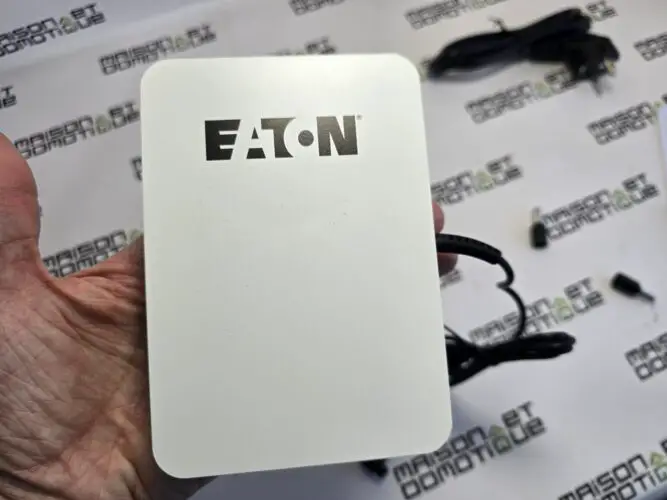
The UPS itself is surprisingly lightweight (only 400 grams) and compact, with dimensions of 136 mm in length, 95.5 mm in width and 30 mm in thickness. You can literally hold it in the palm of your hand! This lightness is explained by the use of lithium-ion batteries, which are much lighter than the lead batteries traditionally used in standard UPS devices.
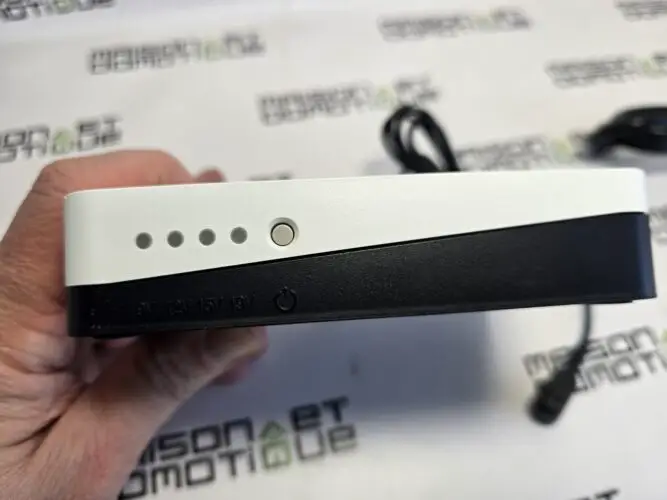
The design is simple and functional, with a front face that includes a power button and several LED indicators. These serve to indicate the battery charge level and the selected output voltage. On the side, there are indications of the different voltages available: 9V, 12V, 15V, and 19V. This versatility is a real plus, allowing for a wide variety of devices to be powered.
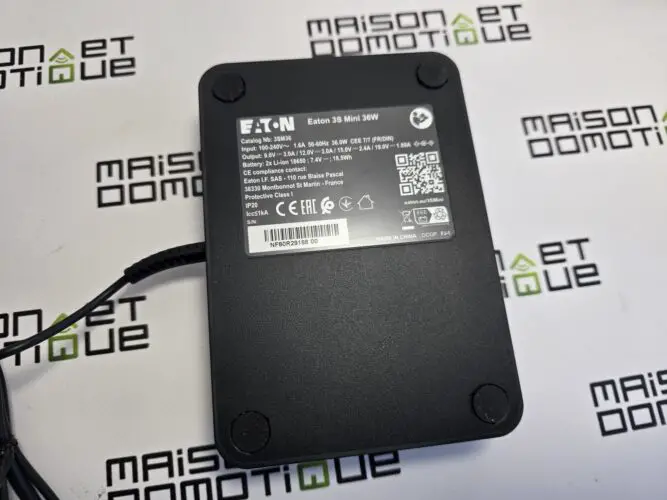
At the back, we find the mains power socket, while the output cable is fixed to the device. This cable ends with a specific connector that requires the use of one of the four supplied tips.
These tips correspond to different dimensions of power connectors commonly found on electronic devices:
- 3.5 mm outer diameter with a 1.3 mm inner hole
- 4.75 mm outer diameter with a 1.7 mm inner hole
- 5.50 mm outer diameter with a 1.7 mm inner hole
- 5.50 mm outer diameter with a 2.5 mm inner hole
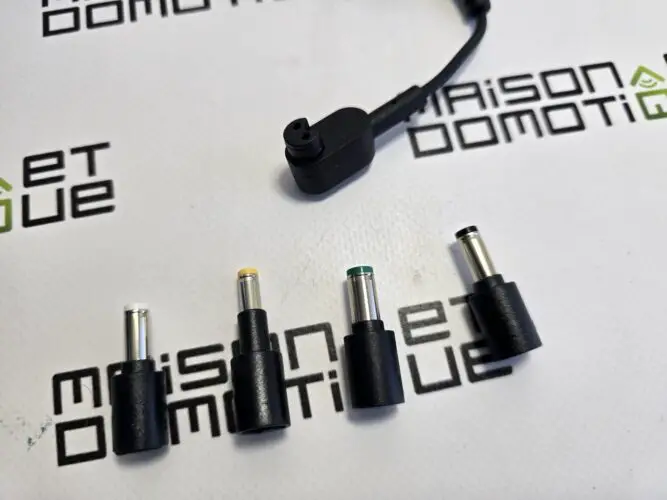
These dimensions cover most of the devices you would want to protect with this UPS. I was pleasantly surprised to find that all my target devices (internet box, IP cameras, Wi-Fi access points) were compatible with at least one of the supplied tips.
The build quality is up to the mark, as one would expect from Eaton, a recognized player in the field of electrical protection. The plastics are of good quality and the assembly shows no visible defects. You can feel that you are dealing with a professional product, despite its compact format.
Setting Up the Eaton 3S Mini
The installation of the Eaton 3S Mini is child’s play, and that's a good thing! No need to be an electricity expert to set up this effective protection.
The first step: choose the device to protect. In my case, I initially opted for my internet box (Orange Livebox), which is often the first victim of power cuts. Then, you need to identify the power supply voltage of the device. Generally, this information is indicated on the original power adapter. My box operates at 12V, so I selected this voltage on the Eaton 3S Mini.
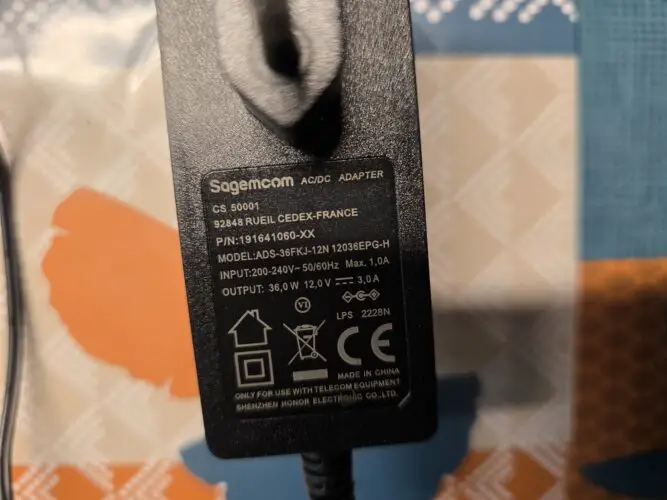
To change the output voltage, you need to hold the power button down for about 8 seconds until the LEDs start to blink. You can then choose the desired voltage by briefly pressing the button, then confirm your choice by holding the button down again for 8 seconds. It’s a bit technical the first time, but you get used to it quickly.
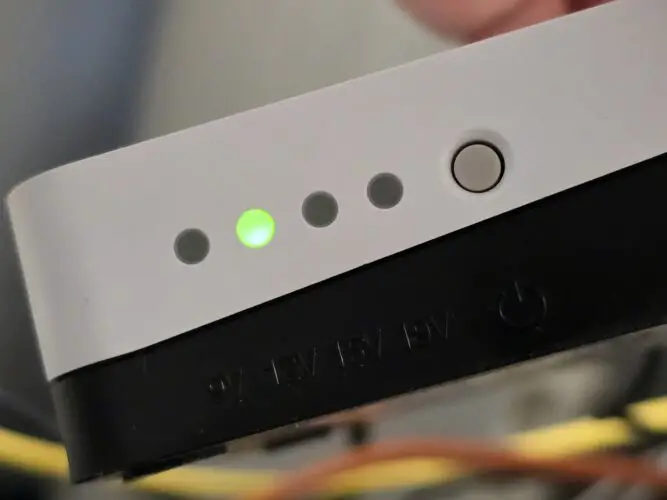
Next, you need to choose the adapter tip that corresponds to the power connector of your device. This is a crucial step because a wrong choice could damage your equipment. I tested the different tips on my box's connector (disconnected, of course!) to find the one that fit perfectly. Once the tip is chosen, you just snap it onto the output cable of the UPS.
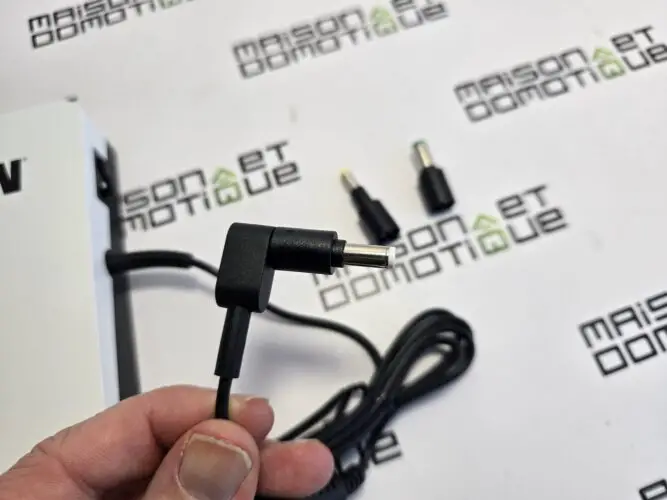
The next step is to plug the UPS into a wall outlet and then connect your device to the UPS via the cable equipped with the appropriate tip. A press on the power button, and there you have it, the Eaton 3S Mini is operational!
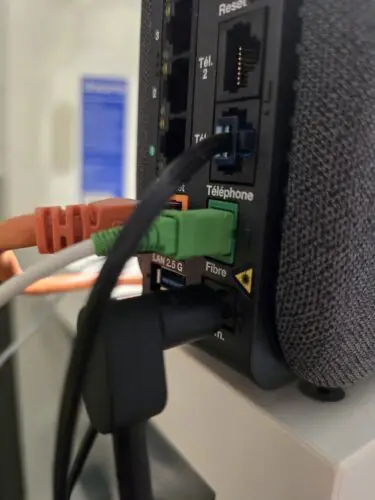
The LEDs light up to indicate the selected output voltage and the battery charge level.
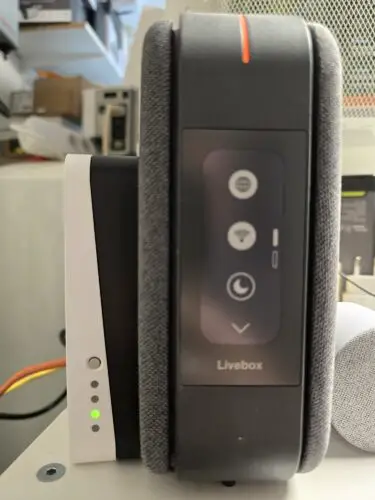
The provided cables are not very long (about 1 meter for the power cable and 1 meter for the output cable), which can be limiting in certain configurations. Therefore, you need to plan to place the UPS close to both a wall outlet and the device to be protected. In my case, this wasn’t a particular issue, but it’s something to consider during installation.
Once the installation is completed, the UPS is easy to forget. It is silent (no fan) and discreet enough to be placed behind a piece of furniture or next to the protected device without drawing attention. This is exactly what one expects from such equipment: to do its job without being noticed.
Feedback
After several weeks of using the Eaton 3S Mini, I can finally share my concrete experience with this handy little device! This compact UPS has proven its worth several times, particularly during a power cut that affected my entire neighborhood for nearly an hour.
Starting with daily use: the Eaton 3S Mini is completely transparent in normal operation. It emits no noise, does not heat up, and simply allows the current to flow to the connected device while recharging its internal battery. The LEDs on the front discreetly indicate the selected output voltage and the battery charge level.
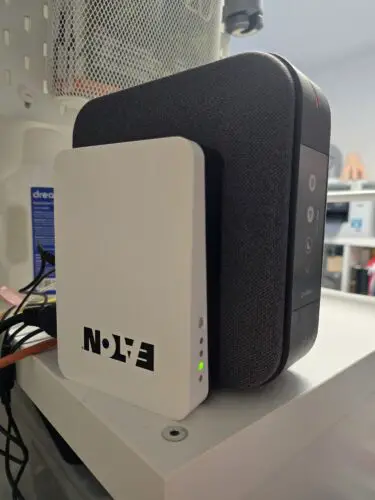
But it is obviously during power cuts that the UPS reveals all its potential. During the aforementioned hour-long power cut, my internet box, protected by the Eaton 3S Mini, continued to function without interruption. I was thus able to stay connected to the Internet via my smartphone and laptop (which had their own batteries), allowing me to continue working without being disturbed. My neighbors, however, lost their connection within the first few seconds of the cut!
The stated autonomy seems to hold up its promises. Here’s what I observed with various devices:
For an IP camera consuming about 3 watts, the autonomy exceeds 4 hours by far. I even reached nearly 5 hours on one of the models, which corresponds to the specifications announced by Eaton.
For my standard internet box (consuming about 10 watts), I obtained an autonomy of about one hour, which is in line with the specifications. It is more than enough to cover the vast majority of home power cuts.
I also tested the UPS with a Wi-Fi repeater (consuming about 7 watts) and obtained an autonomy of about 2 hours. Again, this is consistent with the manufacturer's promises.
One particularly interesting point is how the Eaton 3S Mini manages the transition between mains power and battery. This transition is completely transparent for the connected device, which suffers no interruption. This is crucial for equipment like internet boxes or surveillance cameras, which could reset in the case of a cut, even very brief.
In terms of electrical performance, the UPS delivers a maximum power of 36 watts, which is sufficient for most home connected devices. The available output voltages (9V, 12V, 15V, and 19V) cover almost all needs. Here are the maximum currents available for each voltage:
- 9V: 3A
- 12V: 3A
- 15V: 2.4A
- 19V: 1.89A
These values are important to verify to ensure that the UPS can correctly power your device. In my case, all the devices I wished to protect were within the supported limits.
A particularly relevant use case that I experienced concerns surveillance cameras. In the event of a power cut, whether accidental or caused by an intruder, traditional cameras stop functioning, creating a security gap. With the Eaton 3S Mini, my IP cameras continued to operate and record for the entire duration of the cut. This is a significant bonus for home security.
I also appreciated the ability to use this UPS during interventions on the electrical panel. By temporarily protecting my internet box, I was able to maintain my Internet connection while I turned off the main circuit breaker to perform repairs. It’s a valuable comfort that avoids tedious restarts of certain equipment.
Another interesting use scenario concerns home automation equipment. If you have a central home automation controller (such as Jeedom, Home Assistant, or others), protecting it with the Eaton 3S Mini allows you to maintain the operation of your home automation system even during a power cut. This way, you retain control over your devices and remote access to your system.
In terms of durability, the integrated lithium-ion battery should offer good longevity. Eaton announces a two-year warranty, which is reassuring. It is difficult to speculate on the actual lifespan of the battery after only a few weeks of use, but the build quality suggests good longevity.
One point worth mentioning is the ease of reading the LED indicators. In normal operation, a green light indicates the selected voltage. In the event of a power cut, the LEDs indicate the remaining battery charge level, with a blinking system that allows easy tracking of the remaining autonomy. It’s simple and effective.
Finally, I appreciated the versatility of this UPS. Beyond its primary use to protect an internet box or a camera, it can serve in many situations where a continuous power supply is necessary. I even temporarily used it to power an external hard drive during a critical backup that I did not want to be interrupted by a potential power cut.
Conclusion: a small UPS that does a big job
After several weeks of intensive use, the Eaton 3S Mini has greatly earned my trust. This small UPS fulfills its mission perfectly: to protect essential connected devices against power cuts and electrical disturbances.
Its strengths are undeniable: an ultra-compact format that allows it to be placed anywhere, impressive autonomy for its size, remarkable versatility thanks to the different available voltages and the supplied adapters, and ease of use that makes it accessible to all. All for a reasonable price around 50€, making it a wise investment to protect equipment often far more expensive.
Of course, it also has some limitations. It can only protect one device at a time, its maximum power of 36 watts excludes more power-hungry equipment, and the provided cables could have been a bit longer to facilitate certain installations. But these drawbacks are minor compared to the services rendered.
The Eaton 3S Mini is mainly aimed at owners of critical connected devices: internet boxes, surveillance cameras, home automation controllers, voice assistants, etc. For these devices, it offers effective protection against electrical network fluctuations, avoiding unexpected restarts and data loss.
In a world where we are increasingly dependent on our connections and connected devices, the Eaton 3S Mini appears as a discreet but effective guardian of our digital comfort. It is one of those devices whose value can truly only be measured when needed, but from which one cannot do without once tasted.
In short, if you are looking for a simple and effective solution to protect your essential connected devices against power cuts, the Eaton 3S Mini is an obvious choice. Its quality-price ratio is excellent, and the peace of mind it offers is well worth the investment. It is one of those small devices that significantly enhance our digital daily life without being noticed. And isn’t that the definition of a successful product?

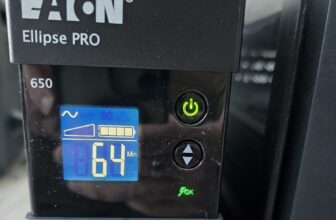
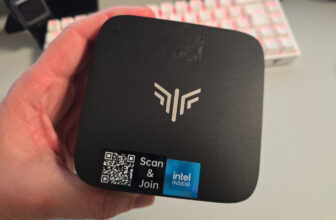
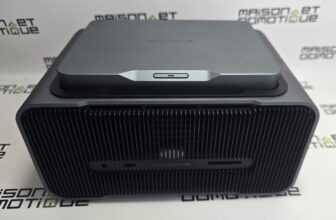
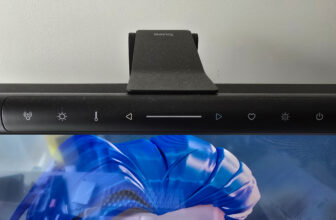

Please remain courteous: a hello and a thank you cost nothing! We're here to exchange ideas in a constructive way. Trolls will be deleted.